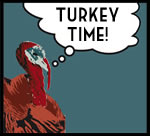There’s nothing like a local turkey, and it’s definitely time to order your holiday bird if you haven’t already!
Choose from a wide variety of pasture raised heritage birds, including apple finished from New Roots Farm and hops fed from White Gate Farm.
Here’s the full list of local farms that have turkeys available for the 2013 holiday season >
Turkey talk, from the archives
originally posted in 2009 by Debra, the discourse on the best method to prepare a turkey continues:
To brine or not to brine? To cook at high heat or low heat? To help you decide, ”A Thanksgiving turkey worth its salt” tests different brining as well as cooking techniques, and comes down in favor of dry brining:
The best-browned bird was the one we had brined. It was very moist both in the breast meat and in the thigh. And the flavor was good, not salty but well-seasoned throughout. However, it didn’t have the best texture it was slightly spongy.
The high-temperature experiment was not as successful. Far from solving the problem of doneness between dark and white meat, this magnified it. The flavor was fine, and the skin was brown and crisp. But the breast meat had started to dry out, while the dark meat was underdone rubbery rare-poultry texture and pink juice in the hip joint.
But the bird that was exciting was the one we had “Judy-ed.” This one had been cured in salt and was firm, meaty and smoothly dense. Though it was a bit too salty, the underlying flavor of the turkey was amazingly deep and full.
Suddenly, my Thanksgiving menu plans took a turn. The “Judy-ed” bird, though it needed refinement to tone down the salt and crisp and brown the skin, was the clear Smackdown winner.
To further refine the salt-cured turkey, we cooked it again, this time reducing the salt, allowing only 1 tablespoon for every 5 pounds of bird. To improve the browning, we started roasting the bird at 425 degrees for 30 minutes instead of 375 degrees. And we brushed half of the bird with melted butter before it went into the oven to see what effect that had on browning and flavor…
Last year I avoided the question altogether by braising my Narragansett turkey. The results were as described by Mark Bittman delicious and succulent, however it wasn’t roast turkey. I haven’t yet decided what I’ll be doing this year. What method do you use to cook your locally raised turkey?
This description of the “butcher’s method” of carving should help those who are either new to the art of carving or just want to avoid public embarrassment. The task usually falls on my husband and he swears by it.

